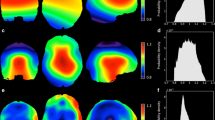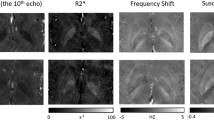Abstract
We implemented a 3D co-registration technique based on mutual information (MI) including 2D image matching as a coarse pre-registration. The 2D coarse pre-registration was performed in the transverse, sagittal and coronal planes sequentially, and all six parameters were then optimized as fine registration. Normalized mutual information (NMI) was also examined as another entropybased measure that was invariant to the overlapped area of two images. In order to compare accuracy and precision of the present method with a conventional two-level multiresolution approach, simulation was performed by 100 trials with the random initial mismatch of ±10° and ±17.92 mm (Type-I) and ±20° and ±40.32 mm (Type-II). For Type-I, no significant differences were found between registration errors of the multiresolution approach and the present method with the MI criterion. No biases were observed (≤0.13° and ≤0.57 mm for the multiresolution approach; ≤0.12° and ≤0.57 mm for the present method) and the SDs were very small (≤0.18° and ≤0.12 mm for the multiresolution approach; ≤0.11° and ≤0.11 mm for the present method). For Type-II, SDs for the multiresolution approach (≤1.8° and ≤0.88 mm) were markedly larger than those for the present method (≤0.64° and ≤0.20 mm) with MI. Success rate for the present method was 99.9%, which was higher than 97.6% for the multiresolution approach. Simulation also revealed that MI and NMI performance were almost equivalent. The choice of optimization strategy more affected accuracy and reproducibility than the choice of the registration criterion (MI or NMI) in our simulation condition. The present method is sufficiently accurate and reproducible for MRI-SPECT registration in clinical use.
Similar content being viewed by others
References
Wahl RL, Quint LE, Cieslak RD, Aisen AM, Koeppe RA, Meyer CR. “Anatometabolic” tumor imaging: fusion of FDG PET with CT or MRI to localize foci of increased activity.J Nucl Med 1993; 34: 1190–1197.
Pohjonen HK, Savolainen SE, Nikkinen PH, Poutanen VP, Korppi-Tommola ET, Liewendahl BK. Abdominal SPECT/ MRI fusion applied to the study of splenic and hepatic uptake of radiolabeled thrombocytes and colloids.Ann Nucl Med 1996; 10: 409–417.
Forster GJ, Laumann C, Nickel O, Kann P, Rieker O, Bartenstein P. SPET/CT image co-registration in the abdomen with a simple and cost-effective tool.Eur J Nucl Med Mol Imaging 2003; 30: 32–39.
Suga K. Technical and analytical advances in pulmonary ventilation SPECT with xenon-133 gas and Tc-99m- Technegas.Ann Nucl Med 2002; 16: 303–310.
Takahashi Y, Murase K, Higashino H, Mochizuki T, Motomura N. Attenuation correction of myocardial SPECT images with X-ray CT: effects of registration errors between X-ray CT and SPECT.Ann Nucl Med 2002; 16: 431–435.
Zaidi H, Montandon ML, Slosman DO. Magnetic resonance imaging-guided attenuation and scatter corrections in three-dimensional brain positron emission tomography.Med Phys 2003; 30: 937–948.
Woods RP, Mazziotta JC, Cherry SR. MRI-PET registration with automated algorithm.J Comput Assist Tomogr 1993; 17: 536–546.
Ardekani BA, Braun M, Hutton BF, Kanno I, Iida H. A fully automatic multimodality image registration algorithm.J Comput Assist Tomogr 1995; 19: 615–623.
Barnden L, Kwiatek R, Lau Y, Hutton B, Thurfjell L, Pile K, et al. Validation of fully automatic brain SPET to MR co- registration.Eur J Nucl Med 2000; 27: 147–154.
West J, Fitzpatrick JM, Wang MY, Dawant BM, Maurer CR Jr, Kessler RM, et al. Comparison and evaluation of retrospective intermodality brain image registration techniques.J Comput Assist Tomogr 1997; 21: 554–566.
Strother SC, Anderson JR, Xu XL, Liow JS, Bonar DC, Rottenberg DA. Quantitative comparisons of image registration techniques based on high-resolution MRI of the brain.J Comput Assist Tomogr 1994; 18; 954–962.
Collignon A, Maes F, Delaere D, Vandermeulen D, Suetens P, Marchai G. Automated multi-modality image registration based on information theory. In Bizais Y, Barillot C, Di Paola R (eds),Information Processing in Medical Imaging. Dordrecht, Kluwer Academic Publishers, 1995: 263–274.
Viola P, Wells WM III. Alignment by maximization of mutual information. InProc. 5th Int. Conf. Computer Vision, Cambridge, MA, 1995: 16–23.
Maes F, Collignon A, Vandermeulen D, Marchai G, Suetens P. Multimodality image registration by maximization of mutual information.IEEE Trans Med Imaging 1997; 16: 187–198.
Wells WM III, Viola P, Atsumi H, Nakajima S, Kikinis R. Multi-modal volume registration by maximization of mutual information.Med Image Anal 1996; 1: 35–51.
Studholme C, Hill DL, Hawkes DJ. Automated threedimensional registration of magnetic resonance and positron emission tomography brain images by multiresolution optimization of voxel similarity measures.Med Phys 1997; 24: 25–35.
Skalski J, Wahl RL, Meyer CR. Comparison of mutual information-based warping accuracy for fusing body CT and PET by 2 methods: CT mapped onto PET emission scan versus CT mapped onto PET transmission scan.J Nucl Med 2002; 43: 1184–1187.
Thurfjell L, Lau YH, Andersson JL, Hutton BF. Improved efficiency for MRI-SPET registration based on mutual information.Eur J Nucl Med 2000; 27: 847–856.
Zhu YM, Cochoff SM. Influence of implementation parameters on registration of MR and SPECT brain images by maximization of mutual information.J Nucl Med 2002; 43: 160–166.
Studholme C, Hill DLG, Hawkes DJ. An overlap invariant entropy measure of 3D medical image alignment.Pattern Recognition 1999; 32: 71–86.
Denton ER, Sonoda LI, Rueckert D, Rankin SC, Hayes C, Leach MO, et al. Comparison and evaluation of rigid, affine, and nonrigid registration of breast MR images.J Comput Assist Tomogr 1999; 23: 800–805.
Holden M, Hill DL, Denton ER, Jarosz JM, Cox TC, Rohlfing T, et al. Voxel similarity measures for 3-D serial MR brain image registration.IEEE Trans Med Imaging 2000; 19: 94–102.
Radau PE, Slomka PJ, Julin P, Svensson L, Wahlund L-O. Evaluation of linear registration algorithms for brain SPECT and the errors due to hypoperfusion lesions.Med Phys 2001; 28: 1660–1668.
Shannon CE. A mathematical theory of communication.Bell System Technical Journal 1948; 27: 379–423/623–656.
Neider JA, Mead R . A simplex method for function minimization.Comput J 1965; 308-313.
Press WH, Teukolsky SA, Vetterling WT, Flannery BP.Numerical Recipes in C: Japanese Edition. Gijutsu Hyoron Sha, 1993: 295-299.
Friston KJ, Holmes AP, Worsley KJ, Poline JP, Frith CD, Frackowiak RSJ. Statistical parametric maps in functional imaging: a general linear approach.Human Brain Mapping 1995; 2: 189–210.
Renkin EM. Transport of potassium-42 from blood to tissue in isolated mammalian skeletal muscles.Am J Physiol 1959; 197: 1205–1210.
Crone C. The permeability of capillaries in various organs as determined by use of the ‘indicator diffusion’ method.Acta Physiol Scand 1963; 58: 292–305.
Tsuchida T, Yonekura Y, Nishizawa S, Sadato N, Tamaki N, Fujita T, et al. Nonlinearity correction of brain perfusion SPECT based on permeability-surface area product model.J Nucl Med 1996; 37: 1237–1241.
Hudson HM, Larkin RS. Accelerated image reconstruction using ordered subsets of projection data.IEEE Trans Med Imaging 1994; MI-13: 601–609.
Wong JC, Studholme C, Hawkes DJ, Maisey MN. Evaluation of the limits of visual detection of image misregistration in a brain fluorine-18 fluorodeoxyglucose PET-MRI study.Eur J Nucl Med 1997; 24: 642–650.
Maes F, Vandermeulen D, Suetens P. Comparative evaluation of multiresolution optimization strategies for multi- modality image registration by maximization of mutual information.Med Image Anal 1999; 3: 373–386.
Bernon JL, Boudousq V, Rohmer JF, Fourcade M, Zanca M, Rossi M, et al. A comparative study of Powell’s and Downhill Simplex algorithms for a fast multimodal surface matching in brain imaging.Comput Med Imaging Graph 2001; 25: 287–297.
Lin KP, Huang SC, Yu DC, Melega W, Barrio JR, Phelps ME. Automated image registration for FDOPA PET studies.Phys Med Biol 1996; 41: 2775–2788.
Grova C, Biraben A, Scarabin J-M, et al. A methodology to validate MRI/SPECT registration methods using realistic simulated SPECT data. Niessen W, Viergever M (eds), In MICCAI 2001,Lecture notes in Computer Science 2001; 2208: 275–282.
Pluim JP, Maintz JB, Viergever MA. Image registration by maximization of combined mutual information and gradient information.IEEE Trans Med Imaging 2000; 19: 809–814.
Thevenaz P, Unser M. A pyramid approach to sub-pixel image fusion based on mutual information.Proc IEEE Int Conf on Imag Proc ICIP ’96 1996; 1: 261–264.
Meijering EH, Niessen WJ, Viergever MA. Quantitative evaluation of convolution-based methods for medical image interpolation.Med Image Anal 2001; 5: 111–126.
Tsao J. Interpolation artifacts in multimodality image registration based on maximization of mutual information.IEEE Trans Med Imaging 2003; 22: 854–864.
Carrillo A, Duerk JL, Lewin JS, Wilson DL. Semiautomatic 3-D image registration as applied to interventional MRI liver cancer treatment.IEEE Trans Med Imaging 2000; 19: 175–185.
Author information
Authors and Affiliations
Corresponding author
Rights and permissions
About this article
Cite this article
Yokoi, T., Soma, T., Shinohara, H. et al. Accuracy and reproducibility of co-registration techniques based on mutual information and normalized mutual information for MRI and SPECT brain images. Ann Nucl Med 18, 659–667 (2004). https://doi.org/10.1007/BF02985959
Received:
Accepted:
Issue Date:
DOI: https://doi.org/10.1007/BF02985959




